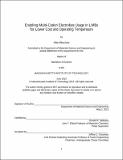Enabling multi-cation electrolyte usage in LMBs for lower cost and operating temperature
Author(s)
Blanchard, Allan (Allan B.)
DownloadFull printable version (3.172Mb)
Alternative title
Enabling multi-cation electrolyte usage in liquid metal batteries for lower cost and operating temperature
Other Contributors
Massachusetts Institute of Technology. Department of Materials Science and Engineering.
Advisor
Donald R. Sadoway.
Terms of use
Metadata
Show full item recordAbstract
Alloy anodes form a promising path to the use of multi-cation electrolytes by increasing chemical stability. In this study, a lithium-magnesium alloy anode was developed such that lower cost and lower melting temperature multi-cation electrolytes could be incorporated in liquid metal batteries (LMBs). In a first part of this work, Lithium-magnesium was proven to be a viable anode in a standard uni-cation (Li+) Li-Mg/LiCl-LiF-LiI/Sb-Pb battery. SEM and EDS confirmed the stability of this anode with respect to the cathode (Sb-Pb) and the standard uni-cation electrolyte. Performance metrics (voltage, efficiencies, etc.) for the Li-Mg anode cell were found to be comparable to the analogous pure Li anode system. In a second part of this work, using the alloyed Li-Mg anode, we demonstrated successful cycling of cells using multi cation electrolytes in Li-Mg/LiBr-KBr/Sb-Pb and Li-Mg/LiCl-KCl/Sb-Pb LMBs. Each of these multi-cation electrolyte systems boasted an active materials energy cost of (<150$/kWh), which is less expensive than the metric cost to implement storage batteries in the electrical grid.[1] These results open the door to incorporating lower cost and lower melting temperature electrolyte candidates in LMBs by using alloyed anodes.
Description
Thesis (S.B.)--Massachusetts Institute of Technology, Dept. of Materials Science and Engineering, 2013. This electronic version was submitted by the student author. The certified thesis is available in the Institute Archives and Special Collections. Cataloged from student-submitted PDF version of thesis. Includes bibliographical references (p. 60-61).
Date issued
2013Department
Massachusetts Institute of Technology. Department of Materials Science and EngineeringPublisher
Massachusetts Institute of Technology
Keywords
Materials Science and Engineering.